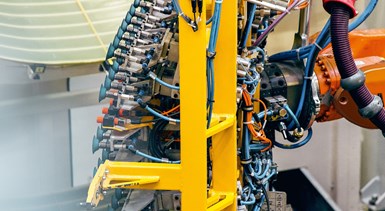SGL Carbon produces composite leaf springs for Ford Transit
The glass fiber composite, longitudinal leaf springs are said to weigh 50% less than conventional steel springs.

Source | SGL Carbon
SGL Carbon (Wiesbaden, Germany) announced on Dec. 11 that it is producing glass fiber composite, longitudinal leaf springs for Ford Transit rear axles in series. This is Ford’s first leaf spring project with composites in series worldwide.
The springs, intended for use with the Transit Skeleton chassis, are designed for high payloads and increased security standards, though are said to weigh about 50% less than conventional steel leaf springs. The serial application is supported by a one-to-one compatibility with standard steel springs.

Source | SGL Carbon
According to SGL Carbon, these leaf springs are the first to be manufactured with pre-impregnated glass fiber fabrics, which are produced at the SGL Carbon site in Willich, Germany. The SGL Carbon component plant in Innkreis, Austria, is responsible for the development and serial production of the springs, and the final products are delivered ready to install to the Ford-Otosan assembly plant in Kocaeli, Turkey.
“The design of these composite longitudinal leaf springs for the Ford Transit Skeleton chassis is yet another milestone in the development of production-ready lightweight leaf springs. They are not only characterized by their special material properties and semi-automatic production, but especially by their high compatibility with various customer model variants,” says Sebastian Grasser, head of the Automotive Composites – Fibers & Materials business unit at SGL Carbon.
Related Content
-
ZEBRA project demonstrates closed-loop wind recycling system
Consortium partners have proven the complete recycling of thermoplastic wind turbines via two manufactured wind blades, featuring reduced operating cost, CO2 emissions.
-
Jeep all-composite roof receivers achieve steel performance at low mass
Ultrashort carbon fiber/PPA replaces steel on rooftop brackets to hold Jeep soft tops, hardtops.
-
Real-time assessment of thermoset composites curing
The combination of material state management (MSM) software and an encapsulated sample rheometer (ESR) enables real-time cure recipe management or cure model development inside the autoclave.

.jpg;width=70;height=70;mode=crop)














